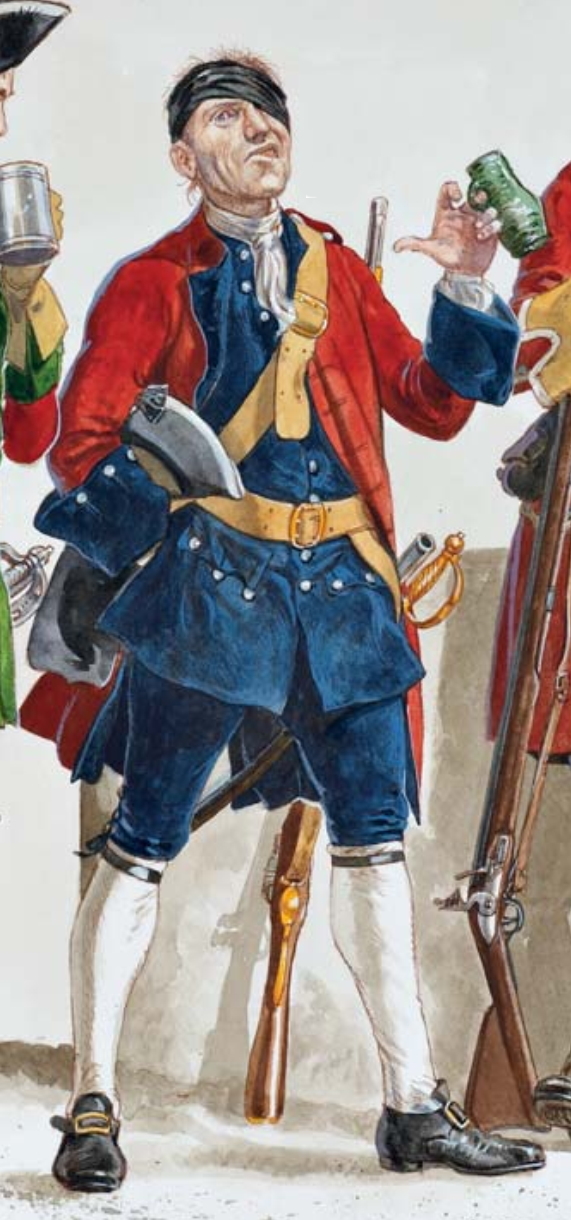
Soldiers disabled by old age, wounds or other infirmities but still willing and able to serve could apply to be posted to the various Independent Companies of Invalids scattered around the British Isles, doing garrison duty at the more substantial fixed military establishments, or acting as caretakers and storekeepers in smaller ones, such as Ruthven Barracks in the Highlands. Thus when Sgt Terry Molloy, left in charge of that post, was summoned to surrender to the rebels in August 1745, he answered that he `would take his chance’ despite his garrison comprising just 12 men `whereof three were useless’. Given that the Invalids quite literally included the halt, the lame and the partially blind, that may not have been too uncharitable a description. (Molloy was not himself an Invalid, but served in the ranks of either Guise’s 6th Foot or Lee’s 55th. He was rewarded for his bravery by being commissioned a lieutenant in the latter regiment.) At Carlisle the two Independent Companies were the mainstay of the defence, and when the Militia finally refused to fight Col Durand decided that he could no longer hold out as `we remained with only our few Invalids, who from their great age and infirmities, and from the excessive fatigue they had undergone . were rendered in a manner of no use.’
Plan and elevation of Ruthven Barracks, Kingussie. Each of the two barrack blocks was capable of housing an entire company, and there was adjacent stabling for a troop of dragoons, but when the rebels attacked in August 1745 it was defended only by Sergeant Molloy and 12 men. Promoted to a lieutenancy in recognition of his determination, Terry Molloy had to surrender when the Jacobites brought up artillery in February. When Ruthven fell to its second Jacobite siege on 9th February 1746 the garrison consisted of Sergeant Molloy, one corporal and twelve privates.
privates.
Due to continued unrest, the British government decided to build fortified barracks in strategic locations: the new barracks at Ruthven were completed in 1721 on the castle hilltop. The barracks accommodated 120 troops and 28 horses for dragoons. In August 1745 a unit of 12 soldiers, commanded by a Sergeant Terrence Molloy of the 6th Regiment of Foot, defended the barracks against 200 Jacobites losing just one man, whilst killing at least two Jacobites and wounding many more.
As installations intended to prevent Jacobite uprisings and provide secure bases from which to operate as an army, the fortified barracks and forts showed mixed success when tested during the ’45. On the one hand, the fortified barracks, designed to repel attack by traditional Highland raiding tactics, showed their success. During the first attack on Ruthven in August 1745, the Jacobites attempted the traditional Highland raiding tactic of firing the door before storming through it. Sergeant Molloy defended Ruthven using the design features added to the fortified barracks based on knowledge gained from the success of tower houses; he fired from the corner tower that provided enfilade covering fire. Therefore, the defensive features of the fortified barracks were a success providing the attackers’ tactics were in keeping with the anticipated mode of attack.
Sergeant Terry Molloy, described by General Sir John Cope in 1745 as ‘a verie good sergeant’, received a lieutenant’s commission after he and a dozen men successfully defended Ruthven Barracks against 200 Jacobite rebels. Ten years later, further promotion came after he successfully fought his way out of Braddock’s disaster on the Monongahela river.
The following year Lieutenant Terrence Molloy surrendered to a larger force of Jacobites with two cannons commanded by John Gordon of Glenbuche, after a short siege where the government troops repelled a Jacobite attack, killing many of the Jacobites.